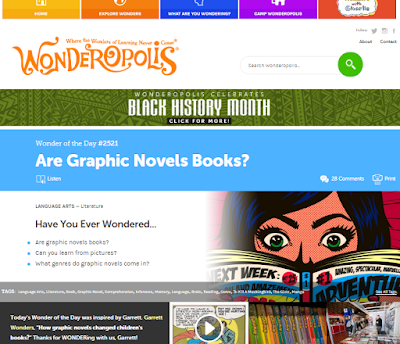 Q: I know that pairing fiction with nonfiction can benefit students in many ways, but I'm often at a loss to find short sources of nonfiction at an appropriate level for my students. How can I pair fiction and nonfiction easily?
Q: I know that pairing fiction with nonfiction can benefit students in many ways, but I'm often at a loss to find short sources of nonfiction at an appropriate level for my students. How can I pair fiction and nonfiction easily?Nearly any topic or theme you might address through fiction has a counterpart in juvenile or young adult nonfiction. In a previous post, for example, I discussed how famous figures from history could be explored through biographical picture books. I also shared book pairings for Animals, Invention, the Civil Rights Movement, the American Revolution, the American Civil War, the Holocaust, Jewish Resistance in the Holocaust, and Women's History to name but a few topics.
But a resource I've been recommending recently to colleagues at conferences and through my PLN is Wonderopolis. Wonderopolis is a well designed, daily-updated collection of topics from Science, Health, Social Studies, Language Arts, Technology, and Arts & Culture.
Each Wonderopolis entry features
- prereading questions (to provide objectives for reading),
- a student friendly article, with highlighted vocabulary which can be defined with a simple mouse-over,
- a "Wonder Words" vocabulary bank (with optional quiz),
- a "Did You Get It?" multiple choice quiz,
- a list of Common Core standards,
- some "Try It Out" activities which can be completed as class or home extensions,
- and the opportunity for students to join a discussion about the topic through the site's moderated discussion forum.
A list of sources also accompanies each article, should students or educators choose to pursue further research.
The video below provides an overview of the site and its features.
- Students could access this site as a part of their daily routine (some teachers might call this bell work). The articles are engaging and the assessments are low-key.
- Many of the topics discussed could serve as current event pieces. Some educators, with good reason, are hesitant to allow students to search out current events topics. Using this site as the source, however, guarantees that the content is school appropriate and rendered at an accessible reading level.
- Teachers can use this site, paired with an appropriate picture book, to initiate discussion of sensitive topics such as bias and stereotype. For example, the wonderful picture book What Riley Wore by Elana K. Arnold and Linda Davick follows "gender-creative Riley (who) knows just what to wear for every occasion." This book would pair well with the Wonderopolis article on "What is Bias and Why Do People Have It?"
- Teachers can pair the nonfiction articles from Wonderopolis with fiction texts. If reading a novel which discusses the Civil Rights Movement, for example, you could search that same term and find articles on Martin Luther King, Jr., Malcolm X, the Freedom Riders, Segregation, the Sit-In Movement, Ruby Bridges, and more. (Some articles may prove more challenging than others, so I recommend that teachers always preview before they assign in order to determine if assignments can be completed independently, or if they are better suited to a paired or full-class approach).
- Students can use this site for independent reading and study. Since many of the posted articles were based upon student questions, even the most reluctant reader will likely find a topic of interest.
- Content area teachers can supplement classroom textbooks.
How do you use this site in your own classroom?
I use this site in all many of the ways mentioned above, but I often supercharge it by adding Insert Learning elements.
Insert Learning embeds instant interactivity on nearly any web page by allowing you to add
- highlights,
- annotations and definitions (to accompany those highlights),
- sticky notes (which can contain plain text, images, links, YouTube videos, or screen casts),
- open ended questions (requiring a student response),
- multiple choice questions (instantaneously graded), and
- discussion questions (the responses to which are visible to all students).
You can read more about Insert Learning in an earlier post, or watch the video below to see how I added additional interactive elements to a Wonderopolis post.













0 comments:
Post a Comment